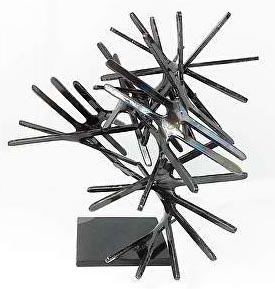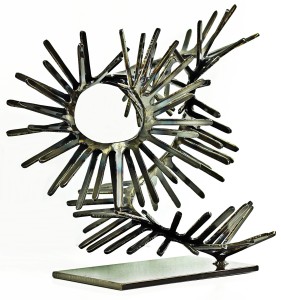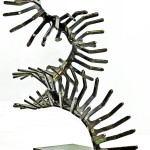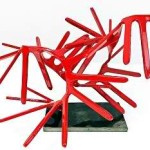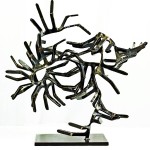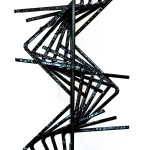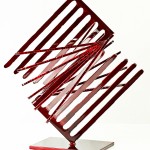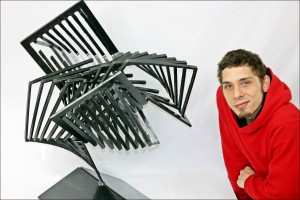
Turry Lindstrom
See more of Turry’s art at: Turry Lindstrom
For interviews with other sculptors see: Bryan Rasmussen / Maria Willison
Turry Lindstrom comes from a family of artists: his father and sister are professional portrait artists, and another sister is a talented vocal artist. Turry’s own early artistic efforts came in junior high school working with clay. He won an award for his work, but found he did not really enjoy that form of sculpting. In 2007 he learned to weld at Chattanooga State College and realized that he had a love for the process of cutting, shaping, and welding steel. When working as an assistant on an ornamental iron project, he began to tap into his artistic leanings by creating human and animal figures from leftover scrap metal. He enjoyed every aspect of making these small figures for family and friends, and began to experiment with different means of fabricating art objects in metal. In the spring of 2013 he took the leap into the world of art, building a small studio at his home to work full time producing metal sculpture. His work has found a very positive reception, selling in Atlanta as well as at the 2014 4 Bridges Art Festival in Chattanooga. He has a one man show at Graffiti Gallery, also in Chattanooga, and has then been invited to show his work at the Gallery DeRubeis in Key West, Florida.
Where do your ideas for your sculptures come from? Do you keep an idea book or sketchbook in which you evolve your designs?
No, I just keep ideas in my head. Lots of ideas cycle through my mind constantly and sometimes one will stand out, but it’s rare that I’ll ever start working on it right away. I usually have to stew on an idea, working it out for days, if not weeks, in my head. Sometimes it helps to do things that help trigger the creativity, like listening to music with my eyes closed as I play with various sculptural images in my mind. I read that Thomas Edison used to doze in a chair with BBs in each hand so that if he left the half-awake/ half-asleep state and began to sleep more deeply, he’d drop the metal balls, and the noise would bring him back to a half-awake state. That was when he was at his most creative, letting his subconscious do the work.
How long do you “stew” on an idea before acting on it?
It varies. Eventually the idea becomes so complete and so compelling that I have to create a work of art. The energy just builds and builds until I almost feel like I’m being shot mentally and physically out of a giant slingshot. At that point I’m really manic in how intensely and rapidly I work. Even though an idea can take weeks, maybe even longer, to come to completion in my mind, it’s usually executed in just a few days of really intense work. When a piece is finally complete, sometimes my arms feel like wet noodles and I’m utterly spent. I’ll get a cup of coffee and sit down to talk with my wife and just fall asleep. It sometimes takes a few days to rest up after I finish a sculpture.
The fact that you plan your work without any aids beyond your mind and memory amazes me since it’s not simple in concept. For instance, in your appropriately named piece “Complexity”, you’ve created a spiral shape that loops around to create a sense of a geometric shape, a circle, that seemingly arises out of a Dionysian vortex of lines.
Well, I’m not saying my way doesn’t have some disadvantages. It’s like my ideas are in folders in my mind, but I’m sure there are some ideas that get lost. That’s just the way it is. The things I see in my mind I can’t get down in a meaningful way in two dimensions. That’s just not in my nature; it just doesn’t work for me. My ideas go straight from a mental state to reality expressed in steel. Of course, there are happy accidents that happen while I’m working on a piece, and those get included in the finished work, but I pretty much know how a piece will look before I begin. Planning the way I do, in my head, is the only way I feel comfortable. For me there’s just a disconnect between the 2D and the 3D worlds—the 2D/3D divide. 2D just does not work in my world. Frankly, when I’ve reached the point where I could model a piece, I might as well just make it. Doing drawings and making models will just sap the energy I try to bring to my work and which is essential to its existence.
Well, your work is all about energy. Each piece almost crackles with energy and movement. Do you feel the immediacy of your process drives this effect?
Absolutely! As I said, I don’t want to use mental energy on anything but the sculpture. That other stuff would just clutter things up. All that stewing on an idea is to lead me to the slingshot moment when the energy is released and the idea becomes the work itself.
Let’s imagine that the slingshot moment has arrived and you go into the studio. What happens next
Well, as you know, I work with steel plate. I’m restricted on size at this point because I have a really tiny studio—I can touch both walls with my hands by holding out my arms going one way, and the other way is about ten feet. It’s okay, I manage, but it’s more like a welding closet than a studio. The steel I use is ¼ inch thick, 12 inches wide, and as long as I need it. For the realization of my ideas at this point that’s just fine. I can see a time when I’ll want to work bigger but my studio size prevents that right now. Still, I’m really excited by the work I’m doing even with these physical limits.
What happens next?
Well, I’ve visualized the finished work, and as part of that process I’ve visualized the cuts I’ll have to make on the flat piece of steel to get the shapes I’ll work with later. I guess you might think of the steel as my canvas. Anyway, then I start to cut.
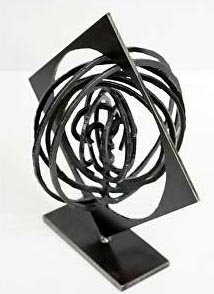
Radial Convergence
With what?
A plasma cutting tool. It weighs almost nothing. I’ve known older steel workers who find it’s too lightweight. They want an acetylene torch that’s heavier. The plasma tool is like a little plastic whip and I can just fly with it. It allows me to come at the work from different angles and just keep moving. The energy flows from my mind, through the torch, and into the steel. Some of the cutting can be repetitive at this point. Normally I hate anything that’s repetitive. When I was punished as a boy and was made to write something over and over, I was, like, just beat me and get it over with! But when I’m making art I just get into a rhythm and it’s okay. I’m planning future steps even as I’m cutting. I work really intensely and really fast at this point. I move so fast that when I’ve worked around other welders I make them nervous and they start saying, “slow down! slow down!”, but that’s just my natural way of working. It’s just the speed I need to go. I know my boundaries and I know I’m safe within them.
So you’ve cut out a shape, but it’s flat. Then what do you do?
Well, at this point in the process the hard work is done. Now the real fun starts. It’s my reward for doing the construction part: the planning, the layout, and the cutting. It’s where the really creative stuff happens. I use an acetylene torch to heat and bend the plate I’ve cut into the larger shape I want. I just keep the torch going and the metal glows red and idea flows out of me and into the metal. In “Complexity”, the torch never went off for 45 minutes as I bent and twisted the 6 foot long piece of steel I’d cut into the sculpture. I was so fired up with my idea for that piece I bent it all up in one go.
How do you bring a sculpture to its finished ‘gallery ready’ state?
I didn’t say it earlier, but I smooth the edges of my cuts before I start bending. In my work, there isn’t a lot of finishing I want to do to my work. I like the viewer to see hints of the process that made the piece, the color changes that result from heating the metal and the marks of the tools. I just take a wire brush and get off the flaky white stuff that oxidizes on the hot metal, then I put on a clear coat. Sometimes I use color, but more often it’s a clear coat. There’s a lot of me in every one of my sculptures: all the music, and movies, and thinking, and just my life generally. I can see it all there. That’s how I know if a piece is any good. I can see me in the work—see me looking back at myself from the finished piece.
In looking at the pieces you have on your website, it seems to me that your work falls into two broad types: a style that is almost a fevered evocation of energy, and another where that energy is somewhat restrained by more geometric elements. Do these two realizations emerge from a common theme?
(To see a larger image, please click on a picture below)
- “Cassiopeia”
- “Undercurrent”
- “Ecstatic”
- “Paradigm Shift”
- “Fractal Vortex”
- “Curiosity”
Yes. I think I’ve been wrestling with bringing a more structured, ‘engineered’ aspect to my ideas. You might say I’ve begun to play with the idea of harmonizing energy and structure. It’s not easy. I thought over Fractal Vortex longer than any other of my works and in the end, when it was about half finished, I had a sudden insight and took it off in a very different direction than I thought I would go.
Your work has so much movement and energy—we keep coming back to that word—that I have to ask if you’ve considered making mobiles?
No, I don’t want to go that route. It wouldn’t work for me. Kinetic involves as much engineering as anything else. It’s very different from the much more spontaneous way I work. Even so, I think the ‘kinetic’ aspect of my sculpture, its appearance of movement, is important. I like it that people touch my sculptures thinking they will move. I take that as a compliment.
I know you’ve told me about the constraints you have with your studio size but will we see some larger pieces coming from you?
I’d like to work bigger someday, but I also want to remain an artist working in metal and not an engineer assembling and erecting big things. Frankly, at this point I don’t see how I can harmonize my way of working with the lengthy process needed to make something really big. Luckily, I have a lot left to do working in my current studio and with my current materials.
What artists have influenced your work?
I have people who I think have influenced my work but it’s not really other sculptors. I like Jackson Pollock and his free and unrestrained approach to the process of art. Otherwise, it’s mainly people working in the movies, H. R. Giger, James Cameron, and Stanley Kubrick. I really admire Kubrick’s attitude. He didn’t make his movies for anyone but himself. He didn’t repeat himself, and he put his soul into every one of them. He shot many takes of just about every scene. He once said, “I don’t know what I want but I know it when I see it.” I understand that. I really only look to myself for the source of my creativity. I explore myself. I challenge myself to keep innovating, keep expanding, and never to repeat.
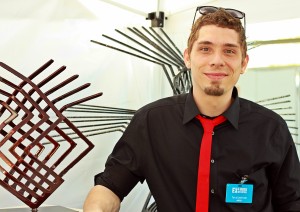
Turry Lindstrom at the 2014 4 Bridges Art Festival
Return to Interviews with Artists
